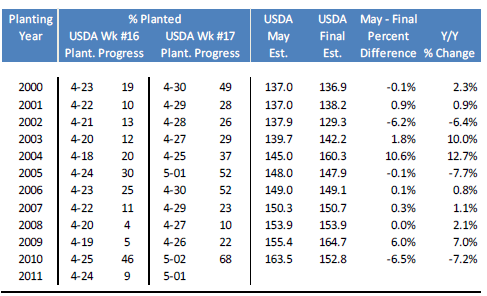



CME: Slow Start to Corn Planting Season
US - With news of the slow start to the corn planting season percolating in the markets, the question many are asking is: what does this mean to me and my business? The quick answer predictably is that it depends, write Steve Meyer and Len Steiner.For corn producers, wet field conditions and the inability to plant the crop in time may mean money left on the table, long nights of worry and extreme toil, racing against time. Studies have shown that corn planted after 15 May may suffer yield loss although much depends on weather during the rest of the growing season. If you are a livestock producer, the slow start to the season adds another element of risk to an already volatile marketplace. Indeed, that volatility may become even more stomach churning as the exchange is contemplating increasing the trading limit for corn from 30 to 50 cents. Supplies of old corn are quickly dwindling and chances are we will start the new marketing year in September with some of the emptiest bins on record. As we have said before, this market has no room for error and we will need above trend yields to start to repair the corn supply situation.

The late start increases the chances that yields may not hit required levels, thus assuring high corn prices in 2011-12. Cattle, hog and poultry producers will likely refrain from any supply increases until they have a better sense of what the crop will be like. The late planting could further delay livestock and poultry expansion. For retailers and foodservice operators, delays in corn plantings imply that wholesale price pressures may persist well into 2012, thus affecting their margins, their customer counts and their plans for future growth.

Advances in technology have made it possible for large farmers to accelerate plantings if weather permits. USDA reported that in week#16 (ending 24 April), just 9 per cent of the corn crop had been planted, compared to 46 per cent a year ago. We had a similar situation in 2008, when in week #16 (ending 20 April) just 4 per cent of the crop had been planted and in week #17 (ending 27 April), 10 per cent of the crop was in the ground. However, by 18 May 2008, 73 per cent of the crop was planted and final yields that year were about the same as the USDA initial trend estimate indicated. See attached table for the relationship between planting dates and final yields. Note that we are using the USDA weekly number identification to make year to year comparisons. One thing that is different this year is that we expect a big increase in corn acres from areas that do not always plant corn. Extreme moisture conditions could cause those ‘intended’ marginal acres to not materialize thus affecting final production prospects. We can still make up the lost ground but risks of a poor crop are increasing with each passing day, especially with forecasts for more precipitation in the next 10 days.









